Description
 The snowy egret is a small heron, about two feet in length with a wingspan of about three feet. It has white feathers, a yellow patch of skin around its eyes, a black bill, and black legs with bright yellow feet. In breeding season, it has lacy plumes on its head, neck, and back and it yellow feet and the the yellow around its bill turns a bit red. Males and females look alike, but males are slightly larger. The snowy egret is a small heron, about two feet in length with a wingspan of about three feet. It has white feathers, a yellow patch of skin around its eyes, a black bill, and black legs with bright yellow feet. In breeding season, it has lacy plumes on its head, neck, and back and it yellow feet and the the yellow around its bill turns a bit red. Males and females look alike, but males are slightly larger.
Range 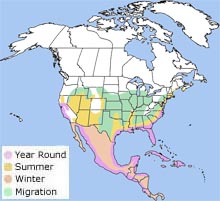 The snowy egret breeds on the Atlantic Coast, the Pacific Coast, and the Gulf Coast. It is also found in some inland areas. It winters from California south to South America on the west coast and from Virginia south to the Caribbean on the east coast. The snowy egret breeds on the Atlantic Coast, the Pacific Coast, and the Gulf Coast. It is also found in some inland areas. It winters from California south to South America on the west coast and from Virginia south to the Caribbean on the east coast.
Habitat
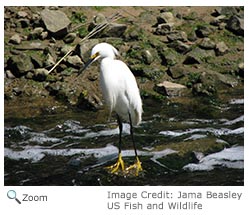 The snowy egret is found in a variety of freshwater and marine habitats with shallow water for feeding. It can be found in salt and freshwater marshes, swamps, shorelines, mudflats, and ponds. The snowy egret is found in a variety of freshwater and marine habitats with shallow water for feeding. It can be found in salt and freshwater marshes, swamps, shorelines, mudflats, and ponds. |
|
Diet
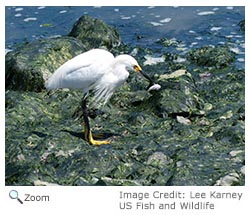 Most of the snowy egret's diet is made up of fish and crustaceans, but it also eats worms, insects, snails, snakes, small lizards and frogs, and aquatic vegetation. Most of the snowy egret's diet is made up of fish and crustaceans, but it also eats worms, insects, snails, snakes, small lizards and frogs, and aquatic vegetation.
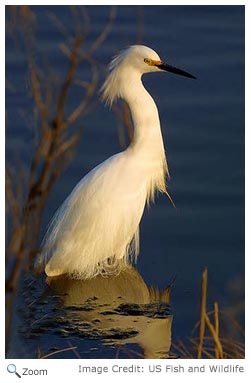 The snowy egret has a lot of strategies for stirring up and locating prey. It runs through shallow water and uses its feet to flush out prey. It stands still in the water waiting for its prey to go by. It walks slowly through the water stirring up the mud with its feet and looking for prey. It stands in the water and stirs up the mud with one foot to flush out prey. It will also fly and hover above the water and then dive to catch its prey, and it will sometimes follow farm animals and eat the insects that are flushed out. The snowy egret has a lot of strategies for stirring up and locating prey. It runs through shallow water and uses its feet to flush out prey. It stands still in the water waiting for its prey to go by. It walks slowly through the water stirring up the mud with its feet and looking for prey. It stands in the water and stirs up the mud with one foot to flush out prey. It will also fly and hover above the water and then dive to catch its prey, and it will sometimes follow farm animals and eat the insects that are flushed out.
Life Cycle
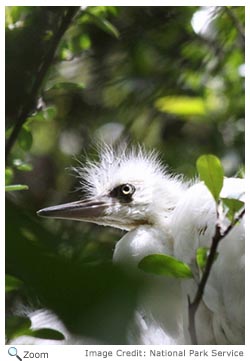 The snowy egret nests in colonies, often with other heron species. The male selects a breeding area. Both the male and female build the nest. The male collects the materials and the female does the constructing. The nest is flat and shallow and is made of reeds and twigs. It lined with small twigs and rushes and placed in a tree or bush or sometimes on the ground. The female lays 3-5 eggs and both parents share incubation duties. The eggs hatch in about three weeks. Both parents care for the chicks and feed them regurgitated food. The chicks fledge when they are about a month old. The snowy egret nests in colonies, often with other heron species. The male selects a breeding area. Both the male and female build the nest. The male collects the materials and the female does the constructing. The nest is flat and shallow and is made of reeds and twigs. It lined with small twigs and rushes and placed in a tree or bush or sometimes on the ground. The female lays 3-5 eggs and both parents share incubation duties. The eggs hatch in about three weeks. Both parents care for the chicks and feed them regurgitated food. The chicks fledge when they are about a month old.
Behavior
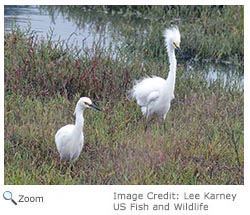 Like other egrets, the snowy egret was once killed for its plumes. Its population was seriously damaged in the 1800s. It has made a recovery and is no longer hunted. Like other egrets, the snowy egret was once killed for its plumes. Its population was seriously damaged in the 1800s. It has made a recovery and is no longer hunted.
|